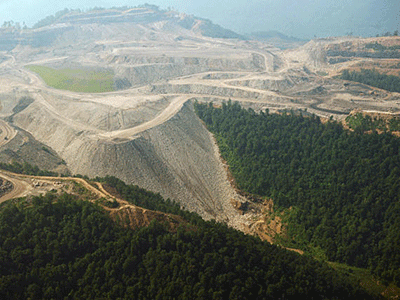Studies have long suggested that people living in Appalachia are at risk for depression due to high poverty rates and environmental disturbances such as coal mining. But can a particular form of coal mining further increase depression rates in this population? According to a study published October 10 in Ecopsychology, it can.
Characterized by the use of explosives and heavy machinery, mountaintop-removal mining (MTR) is an above-ground form of coal mining common in Central Appalachia.
“Mountains are literally blown up and leveled, leaving permanently scarred, treeless landscapes, burying thousands of miles of streams and leaving rock and scrub grass behind where forests used to stand,” said Michael Hendryx, Ph.D., the study’s lead author and a professor in the School of Public Health at Indiana University. “It has permanently deforested and altered a landscape of about 12 million acres, an area roughly the size of Vermont and New Hampshire combined,” he told Psychiatric News.
Other consequences of MTR include increased levels of toxic gases, such as sulfur dioxide and carbon monoxide, and ambient particulate matter that spreads to nearby communities, affecting air and water quality.
In 2011—the year the Environmental Protection Agency finalized regulations to reduce MTR in certain areas—Hendryx and his colleagues at the School of Public Health at the University of West Virginia published a study in the American Journal of Public Health showing that individuals residing in proximal areas to MTR were more likely to experience more days of poor mental health than were those living in areas without MTR.
The researchers decided to extend their studies by investigating whether MTR mining independently contributed to major depressive disorder—a prevalent mental health condition among Appalachian residents.
In the current study, Hendryx and colleagues analyzed data from the 2006 Behavioral Risk Factor Surveillance System, a telephone-based randomized survey of nearly 9,000 inhabitants of Central Appalachian states—Kentucky, Tennessee, Virginia, and West Virginia. The participants were divided into two groups: those living in areas of coal mining and those not living areas of coal mining. The individuals were asked to report any depressive symptoms that occurred over the prior 14 days. They were also evaluated on variables that can influence depression including substance abuse, obesity, and income status. Diagnosis for major depressive disorder was determined with the Patient Health Questionnaire-8 (PHQ-8) scale.
Coal Mining Associated With Increased Depression Risk
After adjusting for covariates that influence depression, results showed that residing in areas of MTR mining increased the risk for depressive symptoms by 40 percent compared with those who were living in an area with no mining. In addition, risk for major depression was 15 percent higher in MTR areas, compared with areas with other forms of coal mining.
“The results of this study demonstrate that residence in an area where mountaintop-removal coal mining is practiced is associated with depression scores independently of income, education, …and other risks,” stated the authors.
Environmental Disturbances Affect Mental State
In addition to pollutants associated with MTR mining, the authors noted that the increased risk for depression in these areas may be due to “solastalgia”—a distress caused by environmental destruction of an area where an individual has deep connections.
“I believe that is true,” said Steven Moffic, M.D., a retired professor of psychiatry at the Medical College of Wisconsin and former president of the American Association for Social Psychiatry.
“Solastalgia is homesickness while still being [at] home,” Moffic explained to Psychiatric News. “The land you were positively attached to is now altered, and you are unable to change that or leave. The psychological ramifications are often a type of grief, which can extend to clinical depression. It would seem to fit those in Appalachia, which at least used to be a beautiful landscape.”
Moffic suggested that the current article “may very well be a landmark in psychiatric and psychological literature” and said that psychiatrists have an ethical responsibility to create dialogue about environmental risks that can affect patients’ physical and mental health.
Hendryx agreed. “In my view, psychiatrists should consider these possible [environmental] impacts in understanding their patients and determining treatment courses.” He concluded by urging all health care professionals who serve people in highly industrial areas to become more knowledgeable about regulations that aim to reduce destructive environmental practices that may impair the mental health and well-being of the people they serve.
The authors reported no funding sources.

